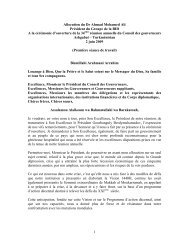Mauritania - Islamic Development Bank
Mauritania - Islamic Development Bank
Mauritania - Islamic Development Bank
You also want an ePaper? Increase the reach of your titles
YUMPU automatically turns print PDFs into web optimized ePapers that Google loves.
• The current rate of progress of 8.5% during the<br />
past decade will be insufficent for <strong>Mauritania</strong><br />
to reach the MDG target for the under-five<br />
mortality rate (from 135 per 1000 live births<br />
in 2000 to around 122 per thousand in 2007,<br />
while the MDG target is 45 set for 2015). There<br />
are also deep inequalities in mortality. The<br />
gaps are 13 points between rural and urban<br />
areas, 84.3 between Dakhlet Nouadhibou and<br />
Guidimagha; 57 between the richest and the<br />
poorest and 49 points depending on the level<br />
of education of the mother.<br />
• Similarly, the maternal mortality rate (MMR)<br />
remains among the highest in the region it<br />
is unlikely that <strong>Mauritania</strong> will achieve the<br />
related MDG target 4. Currently, at 686 per<br />
100,000 live births in 2007, decreasing from<br />
930 in 1990 and 747 in 2000, <strong>Mauritania</strong> is still<br />
far from the target of 232 set for 2015 (MICS).<br />
59. The coverage rate of the Expanded Program<br />
on Immunization (EPI) has been falling for the<br />
past three years and now stands at 76% for<br />
children below five years of age, well below the<br />
85% coverage rate considered by the WHO as<br />
necessary to protect the population.<br />
60. The high CMR is largely due to respiratory<br />
infections and delivery conditions, and living<br />
conditions. Precarious living conditions inherent<br />
in poor and rural areas also play a role (housing,<br />
access to potable water, sanitation etc).<br />
Malnutrition is also factor in child mortality, along<br />
with lack of knowledge of proper childcare in new<br />
mothers.<br />
61. Along with the lack of proper health facilities<br />
and equipment, the high MMR is largely due to<br />
the high proportion of premature and frequent<br />
pregnancies, low access of pregnant women to<br />
quality antenatal care and emergency obstetric<br />
services. Cultural aspects contribute to both of<br />
these factors<br />
62. While the proportion of births attended by<br />
skilled personnel increased from 57% in 2001 to<br />
61% in 2007, the remaining 39% were assisted<br />
by an unqualified person, a relative or without<br />
any type of assistance whatsoever.<br />
2.2 Main Constraints<br />
63. The main constraints to improving the<br />
alarming situation of child and maternal<br />
mortality are closely related to malfunctions<br />
that characterize the entire health system in<br />
<strong>Mauritania</strong>.<br />
Limitations of health services<br />
• Inadequate funding and institutional capacity:<br />
Absence of a clear and coherent policy and a<br />
national health sector plan, coupled with both<br />
underfunding — a paltry US$13 per capita —<br />
and understaffing of the Ministry of Health<br />
(MOH) hinder efficient stewardship role for<br />
the implementation of the Health Sector<br />
<strong>Development</strong> Plan. Also, program execution<br />
in the sector is slowed down by the rapid<br />
turnover of staff holding key positions and<br />
by weaknesses in financial management and<br />
procurement.<br />
• Poor quality of the health management<br />
information system (HMIS/ and lack of<br />
coordination between MOHSA and SECF,<br />
which shares the mandate for malnutrition<br />
prevention and reduction, has been<br />
problematic over the past years.<br />
• Shortages of qualified and motivated health<br />
and social workers along with imbalances<br />
in the skill-mix and uneven geographical<br />
deployment remain among the key factors<br />
affecting the quality and utilization of services.<br />
According to the MOH, 90% of trained<br />
midwifes currently live in Nouakchoutt.<br />
• Inadequate drug quality and supply: Drug<br />
shortages continue to persist in health facilities<br />
and the capacity of the drug procurement<br />
and distribution system needs further<br />
strengthening.<br />
Weak Social Health Determinants<br />
• Inadequate quality control over all<br />
components of the Health Sector (SOPs, drugs<br />
and health commodities, equipment, training,<br />
HMIS etc) is a prevalent feature.<br />
• Low literacy rates especially among women<br />
in the rural areas compounded with deeply<br />
MCPS for <strong>Mauritania</strong>, 2011-2015 17






